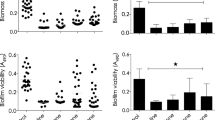Abstract
Forty strains of Acinetobacter were isolated from different environmental sources. All the strains were classified into four genospecies, i.e. A. baumannii (33 isolates), A. calcoaceticus (three isolates), A. junii (three isolates) and A. genospecies3 (one isolate). Susceptibility of these 40 strains to salts of 20 heavy metals and 18 antibiotics was tested by the agar dilution method. All environmental isolates of Acinetobacter were resistant to multiple metal ions (minimum 13 metal ions) while all but one of the strains were resistant to multiple antibiotics (minimum four antibiotics). The maximum number of strains were found to be sensitive to mercury (60% strains) while all strains were resistant to copper, lead, boron and tungsten even at 10 mm concentration. Salts of these four metal ions may be added to the growth medium to facilitate selective isolation of Acinetobacter. Rifampicin and nalidixic acid were the most toxic antibiotics, inhibiting 94.5 and 89.5% of the acinetobacters, respectively. A. genospecies3 was found to be the most resistant species, tolerating high concentrations of all the 20 metal ions and also to a greater number of antibiotics than any other species of Acinetobacter tested. An inhibitory concentration (10 mm) of Ni2+ and Zn2+ was observed to inhibit the growth of all of the clinical isolates but allowed the growth of the environmental isolates, facilitating the differentiation between pathogenic and non-pathogenic acinetobacters.
Similar content being viewed by others
References
Baumann P. 1968 Isolation of Acinetobacter from soil and water. J Bacteriol 96, 39–42.
Bouvet PJM, Grimont PAD. 1986 Taxonomy of genus Acinetobacter with the recognition of Acinetobacter baumannii sp. nov., Acinetobacter haemolyticus sp. nov., Acinetobacter johnsonii sp. nov. and Acinetobacter junii sp. nov., and emended description of Acinetobacter calcoaceticus and Acinetobacter lwoffii. Int J Syst Bacteriol 36, 228–240.
Chopade BA, Wise PJ, Towner KJ. 1985 Plasmid transfer and behavior in Acinetobacter calcoaceticus EBF 65/65. J Gen Microbiol 131, 2805–2809.
Deshpande LJ, Kapadnis BP, Chopade BA. 1993 Metal resistance in Acinetobacter and its relation to β-lactamase production. BioMetals 6, 55–59.
Elek SD, Higney L. 1970 Resistogram typing — a new epidemiological tool: application to Escherichia coli. J Med Microbiol 3, 103–110.
Foster TJ. 1983 Plasmid-determined resistance to antimicrobial drugs and toxic metal ions in bacteria. Microbiol Rev 47, 361–409.
Foster TJ. 1987 The genetics and biochemistry of mercury resistance. CRC Critical Rev Microbiol 15, 117–140.
Glew RH, Moellering RC, Kunz LJ. 1977 Infection with Acinetobacter calcoaceticus (Herellea vaginicola): clinical and laboratory studies. Medicine 56, 79–97.
Holton J. 1983 A note on the preparation and use of a selective differential medium for the isolation of Acinetobacter spp. from clinical sources. J Appl Bacteriol 54, 141–142.
Juni E. 1972 Interspecies transformation of Acinetobacter: Genetic evidence for ubiquitous genus J Bacteriol 112, 917–924.
Krishna Murti CR, Viswanathan P. 1991 Heavy metal pollution in Indian context. In: Krishna Murti CR, Viswanathan P, eds. Toxic Metals in Indian Environment. New Delhi: Tata McGraw-Hill.
Larson EL. 1984 A decade of nosocomial Acinetobacter. Am J Infect Control 12, 14–18.
Nieto JJ, Castello RE, Marquez MC, Ventosa A, Quesada E, Berraquero FR. 1989 Survey of metal tolerance in moderately halophilic eubacteria. Appl Environ Microbiol 55, 2385–2390.
Novick RP, Roth C. 1968 Plasmid determined resistance to inorganic salts in Staphylococcus aureus. J Bacteriol 95, 1335–1332.
Patwardhan RB. 1990 Studies on human pathogenic Acinetobacter species. MPhil Thesis, University of Poona.
Riley TV, Taylor ML. 1989 A note on susceptibility of Branhamella catarrhalis to heavy metals. J Appl Bacteriol 67, 185–189.
Rippere RA, Johnson R. 1986 Chemical and physical properties of antibiotics. In: Lorian V, ed. Antibiotics in Laboratory Medicine. Baltimore, MD: Williams and Wilkins.
Schottel L, Mandal A, Clark D, Silver S, Hedges RW. 1974 Volatilization of mercury and organomercurials determined by F. factor system in enteric bacilli. Nature 251, 335–337.
Silver S, Misra TK. 1988 Plasmid mediated heavy metal resistances. Annu Rev Microbiol 42, 717–743.
Trevors JT, Oddie KM, Belliveau BH. 1985 Metal resistance in bacteria. FEMS Microbiol Rev 32, 39–54.
Wang Y, Mahler I, Levinson HS, Halvorson HO. 1987 Cloning and expression in Escherichia coli of chromosomal mercury resistance genes from a Bacillus sp. J Bacteriol 169, 4848–4851.
Witte W, Green L, Misra TK, Silver S. 1986 Resistance to mercury and the cadmium in chromosomally resistant Staphylococcus aureus. Anntimicrob Agents Chemother 29, 663–669.
Author information
Authors and Affiliations
Rights and permissions
About this article
Cite this article
Dhakephalkar, P.K., Chopade, B.A. High levels of multiple metal resistance and its correlation to antibiotic resistance in environmental isolates of Acinetobacter . Biometals 7, 67–74 (1994). https://doi.org/10.1007/BF00205197
Received:
Accepted:
Issue Date:
DOI: https://doi.org/10.1007/BF00205197




